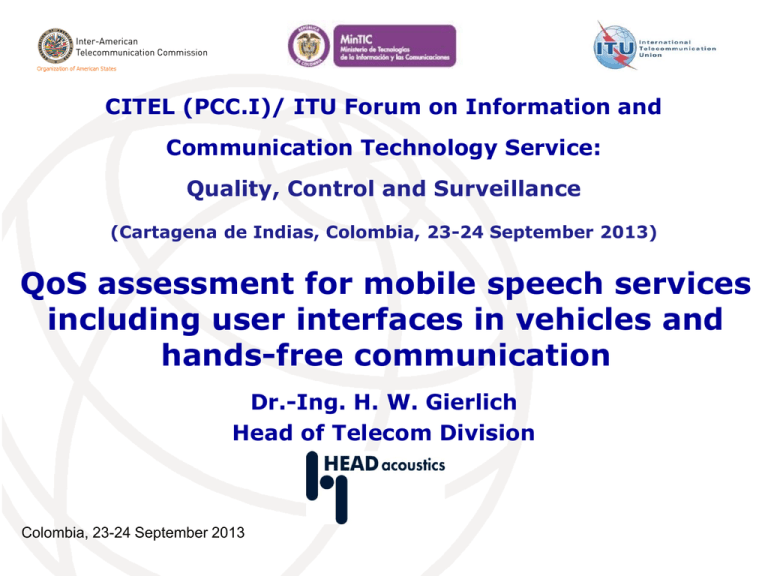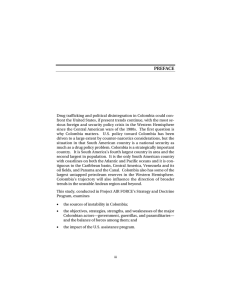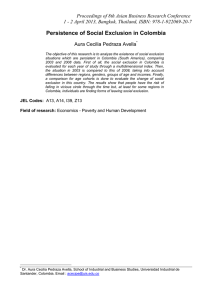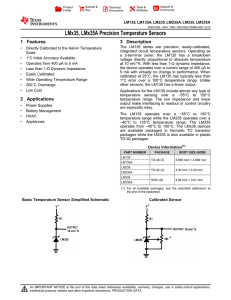QoS assessment for mobile speech services hands-free communication
advertisement

CITEL (PCC.I)/ ITU Forum on Information and Communication Technology Service: Quality, Control and Surveillance (Cartagena de Indias, Colombia, 23-24 September 2013) QoS assessment for mobile speech services including user interfaces in vehicles and hands-free communication Dr.-Ing. H. W. Gierlich Head of Telecom Division Colombia, 23-24 September 2013 Outline Introduction The impact of terminal design on speech quality Assessment methods and standards for mobile terminals Driver distraction and speech services in cars Summary Colombia, 23-24 September 2013 2 Users Expectation (QoE) Listening Effort Sound Quality & Naturalness Intelligibility Speech Characteristics Talking Effort Individual Listening Speech Quality Environmental Conditions Double Talk Performance ... Conversational Effort Network Conditions Expectation Transmission of Background Noise Colombia, 23-24 September 2013 ... 3 Signal Processing in Modern Terminals Noise AGC/ cancellatio companding n … EC EQ Mikrofon – (Array) Coder NLP - NR Coder Modulation / Demodulation H(f ) SE Decoder Important: All signal processing is Loudspeaker z.B. GSM/UMTS non-linear, time variant and SpeechDecoder Comfort targeted“enhancement” to speech enhamcement Noise + EC CN speech recognition/ control Colombia, 23-24 September 2013 4 Speech Quality USERS PERCEPTION …is subjective and generally different between subjects …is based on experience …is cultural dependant TESTING …in general should be based on users perception …may be based on simple signals and procedures modelling aspects of users perception (e.g. loudness) …may be based on complex signals and advanced procedures modelling aspects of users perception (e. g. switching and double talk tests) …may be based on perceptual models using psychoacoustically motivated procedures (models of the human hearing) Colombia, 23-24 September 2013 5 Outline Introduction The impact of terminal design on speech quality Assessment methods and standards for mobile terminals Driver distraction and speech services in cars Summary Colombia, 23-24 September 2013 6 Speech Quality Evaluation Sending SpeechQuality Receiving Quality of Echo Background PerformanceDouble Talk Noise Transm. Colombia, 23-24 September 2013 7 Terminal Testing Bring the world to the lab: Simulate user Simulate user behaviour Simulate user environments Simulate network and access points Simulate network conditions Valdidate correct NTP access Colombia, 23-24 September 2013 8 The Typical Lab Setup Background Noise Subwoofer Simulation Network Simulation Testsystem Colombia, 23-24 September 2013 9 Relevant Standards GPP TS 51.010 (GSM 11.10) 3GPP TS 26.131 & TS 26.132 3GPP2 C.S0056 TIA 928 (CDMA/TDMA) CTIA GSMA HDvoice standard For more advanced testing: ETSI TS 103 737 – TS 103740 standard series Colombia, 23-24 September 2013 10 Moste Important Test Parameters Enabling a Good QoS Performance Basic acoustic tests e.g. Loudness Ratings (ITU-T P.79), Frequency response tests… Delay and echo tests Speech quality tests – with and without background noise Conversational test including double talk, switching… Important: Test signals are mostly speech based – ITU-T P.501 Colombia, 23-24 September 2013 11 The Impcat of Delay on Conversational Dynamics Best case between fixed & mobile network (no satelite): ~150 ms Worst case across networks: >> 500 ms For superior conversational quality: delay < ~150 ms (from the users perspective) Terminal A Colombia, 23-24 September 2013 Network 0 ms 150 ms 500 ms Terminal B 12 Conversational/Double Talk Test Signal Female Male Male Female Receive Send Short isolated words Double talk sentences Word in a speech pause Word in partially masked Word fully masked, one speaker continuosly talking Word conicident with the other channel speaker, Simulating delay and unwanted double talk Colombia, 23-24 September 2013 13 Summary of Quality Parameters Using „Quality Pies“ according to ITU-T P.505 D-Value D-Value BGNT (far) 5 DT Type 8 6/10 -5 2 Subj. Exp. Assessment 4 3 2 Subj. Exp. Assessment poor good fair 6/-2 1,5 40 4/0 good 40 40 3 50 TCLw max 4 G-MOS Mensa G-MOS Mensa N-MOS Mensa N-MOS CAR 3,4 5 3,4 2 G-MOS CAR 2 3,4 3,5 2 5 1,5 4,3 1,5 S-MOS TRAIN 2 2,3 4,3 N-MOS TRAIN 4,3 S-MOS ROAD G-MOS TRAIN 3,2 2,3 3,4 3,5 1,5 2 2 2,3 S-MOS TRAIN 3 3,2 4,3 1,5 G-MOS ROAD N-MOS TRAIN 4,3 S-MOS ROAD G-MOS TRAIN 3,2 2,3 4,3 N-MOS TRAIN 4,3 S-MOS ROAD G-MOS TRAIN 2 2,3 3 3 N-MOS ROAD 3,2 S-MOS TRAIN 2 1,5 2 2,3 4,3 5 2 1,5 2 4,3 G-MOS CAR 2 5 2 3 G-MOS ROAD 2 2 S-MOS Mensa 2 3,2 3 3 N-MOS ROAD 3,2 5 1,5 2 2,3 3 3 N-MOS ROAD 3,2 3,5 1,5 2 2,3 3,2 S-MOS TRAIN 2 1,5 G-MOS CAR 2 1,5 1,5 G-MOS ROAD 2 5 2,3 4,3 5 3,5 2 3,4 3,5 3,4 2 2 3 3,2 N-MOS CAR 3,4 5 3,5 S-MOS Mensa 2 2,3 3 5 5 N-MOS Mensa 3,5 5 2 1,5 2 2,3 3,5 2 2 3,2 G-MOS CAR 2 3,4 S-MOS CAR 5 3,4 5 G-MOS Mensa N-MOS CAR 2 2 S-MOS Mensa Conv. Quality 5 2 OK Echo vs. time S-MOS CAR 3,4 5 3,5 2 5 4 TMOS RCV TCLw nom N-MOS Mensa 3,5 5 2 3 TCLw max OK 5 3,4 3,5 2 G-MOS Mensa N-MOS CAR not Ok 50 Conv. Quality 5 3,4 5 40 Echo vs. time N-MOS Mensa 3,5 RLR nom 2 70 TCLw nom S-MOS CAR 5 5 2 30 3 4 4/0 1,5 40 50 TMOS RCV Conv. Quality S-MOS CAR 5 not Ok TCLw max Echo vs. time Conv. Quality 6/-2 30 2 70 50 OK TCLw nom Echo vs. time G-MOS ROAD 40 4/0 RLR nom 2 TMOS RCV OK poor 70 TMOS RCV S-MOS Mensa 30 70 TCLw nom fair 8/-4 1,5 40 50 4 70 5 30 2 3 50 TCLw max good 5 4 3 2 Subj. Exp. Assessment 6/-2 70 not Ok 2c poor RLR nom 2 70 not Ok 4/0 30 TMOS SND 2/14 2b 8/-4 1,5 40 50 RLR nom 2 70 fair -10 2a 5 4 3 2 Subj. Exp. Assessment 6/-2 30 2 30 50 2/14 8/-4 6/10 4/12 10 1 TMOS SND 2c poor 8/-4 30 8 -5 4/12 2b 5 4 3 0 0 6/10 -5 2c DT Type -10 2a SLR 5 8 10 1 TMOS SND 2/14 5 0 0 4/12 -10 2a 2b 2c DT Type 6/10 -5 TMOS SND 2/14 SLR 5 8 10 1 -10 2b BGNT (far) SLR 0 0 4/12 10 2a fair DT Type D-Value BGNT (far) 5 0 0 1 good D-Value BGNT (far) SLR 3,2 2,3 3 4,3 3 N-MOS ROAD N-MOS TRAIN 3,2 4,3 S-MOS ROAD G-MOS TRAIN Background Noise Performance Phone 1 Phone 2 Colombia, 23-24 September 2013 Phone 3 Phone 4 14 Outline Introduction The impact of terminal design on speech quality Assessment methods and standards for mobile terminals Driver distraction and speech services in cars Summary Colombia, 23-24 September 2013 15 Driver Distraction Physical/manual distraction Manual operation of devices Visual distraction Watching information other than road Auditory distraction Focusing on auditory events not related to the driving task Cognitive distraction Occupied by non driving related tasks Colombia, 23-24 September 2013 16 Technology Based Distraction in Cars Car entertainment systems Navigation systems Phones for speech communication Car information systems Text messanging systems „Texting while driving“ : Colombia, 23-24 September 2013 17 To be Avoided In general all activities distracting from the driving task, esp.: Visual cues which require different focus than road Non intuitive manual operation of the car Loading the human auditory system by distracting cues Unnatural and low quality dialogs and communications Colombia, 23-24 September 2013 18 Driving Task The driving task mostly occupied: visual system not involved: talking mainly involved: hands and legs involved: auditory system => Auditory Channel and Speech “available” Colombia, 23-24 September 2013 19 Speech Based Services in Cars o The main speech applications: • Speech recognition systems • Speech dialog systems • Text to speech systems • Speech enhancement for communication systems • Hands-free communication • Enhanced in-car communication systems between passengers Colombia, 23-24 September 2013 20 Communicational Quality – Drivers Distraction Superior Communication Quality -> Reduced Drivers Distraction Perfekt Intelligibility, High Speech Naturalness in the Car Perfekt Intelligibility, High Speech Naturalness at the Far End Seamless Interaction -> Low Delay, Perfekt Double Talk Performance Colombia, 23-24 September 2013 21 Hands-Free in Cars Why hands-free in cars? Reduce phsyical distraction (dialing, holding the phone…) Reduce visual distraction (watching display, keyboard …) Colombia, 23-24 September 2013 22 Superior Sound Quality & Intelligibility in the Car o Wideband services in mobile networks available soon -> o Enabling wideband telephony (100 Hz- 8 kHz) in cars • Fullband • Narrow band (car) • Wideband (car) o Efficient use of the high quality audio systems in cars: • • • • Getting superior sound quality Increasing speech intelligibility Increasing naturalness of a conversation Reduce drivers distraction due to poor speech sound quality Colombia, 23-24 September 2013 23 Radio Link Bluetooth Link Car audio system Hands-free signal processing Colombia, 23-24 September 2013 Phone adapter & antenna amplifier 24 Car Hands-Free Testing Mobiles Sound Playback System (can be installed in any Test System analysis vehicle) analysis Generator and Analyzer ACQUA Background Noise HFT AES / EBU (Digital) USB (Digital) USB Frontend Programmable Equalizer PEQ IV AES / EBU (Digital) MFE VI Programmable Equalizer PEQ IV AES / EBU (Digital) Programmable Equalizer (Analog) PEQ IV Subwoofer Radio Tester Colombia, 23-24 September 2013 25 ITU-T Standards Contributing to Reduced Drivers Distraction ITU-T standards for Hands-Free Communication: • ITU-T P.1100 for narrowband hands-free • ITU-T P.1110 for wideband hands-free ITU-T standards work in FG CarCOM: • New work on subsystem requirements for Hands-Free Systems in Cars ITU-T standards for Dialog Systems: • P.851: Subj. evaluation of dialog systems • Suppl. 24 to P. Rec.: Parameters describing the interaction with spoken dialog systems Colombia, 23-24 September 2013 26 The Main Section in ITU-T P.1100 & P.1110 Definition of the test arrangement in a car Description of a digital interface concept for development and debugging Microphone test specification for separate microphones in a car Measurement parameters and requirements for hands-free terminals Bluetooth test interface for validation of telephone performance Subjective test strategy for car to car communication Colombia, 23-24 September 2013 27 Conclusions and Recommendations Mobile terminal testing is essential to provide sufficient or even superior QoE to the user – many operator have specific terminal standards for their suppliers A variety of parameters contribute to the overall (conversational) speech quality Network conditions have to be considered in the testing Low driver distraction is essential to offer mobile services Speech based operation is the key to the success of mobile services in cars Both, terminals and networks have to be thoroughly engineered and adapted to each other Colombia, 23-24 September 2013 28 Tandeming of Signal Processing in Terminals & Networks Mobile Phone Mobile Network Base Station gain gain EC EC Netw. 1 ES ES NR Colombia, 23-24 September 2013 NR Netw. 2 29






